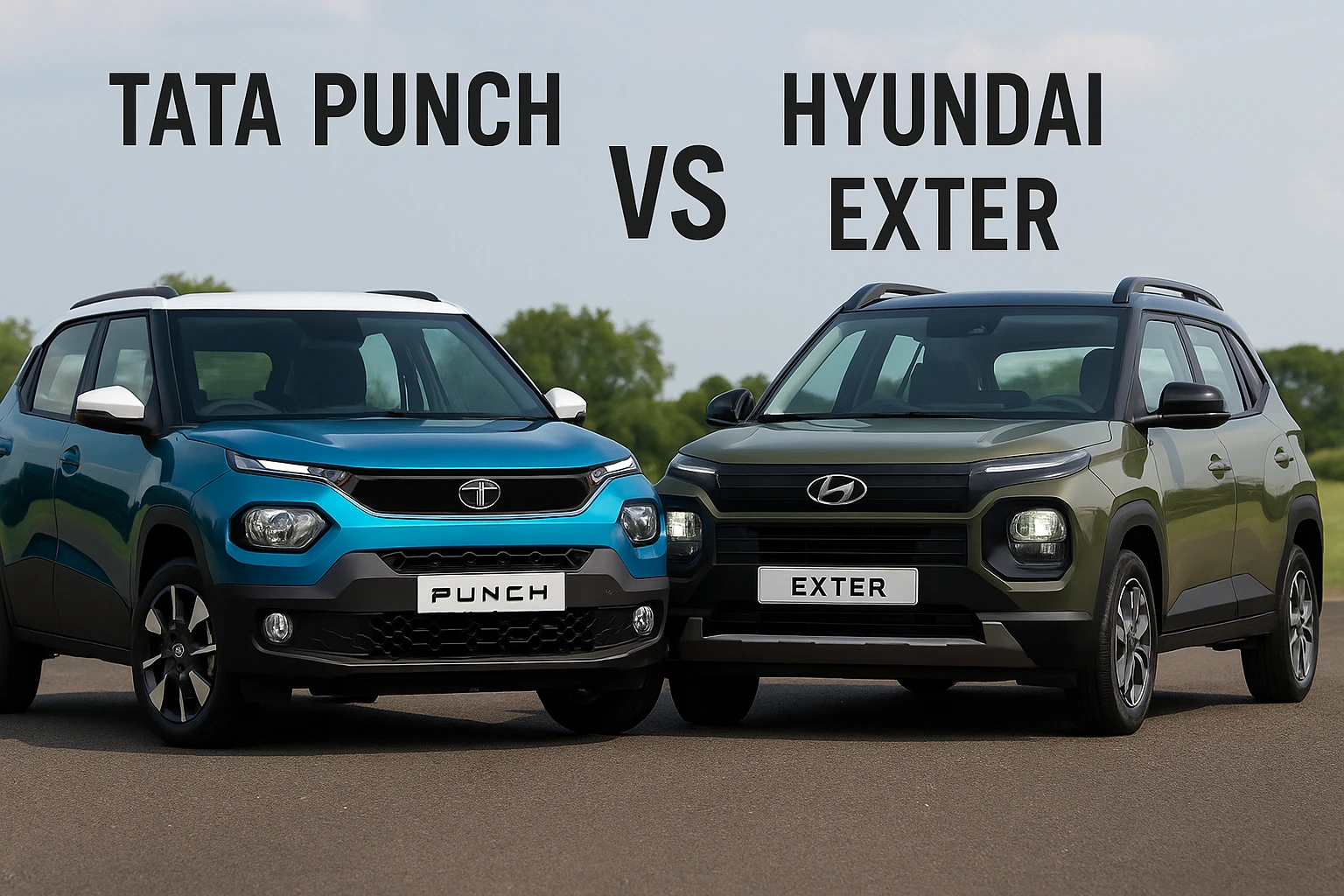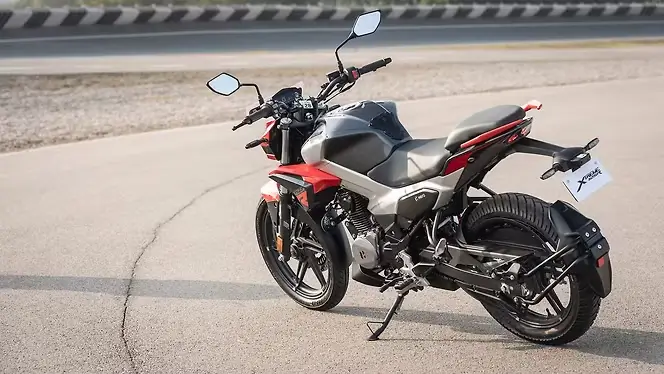Tata Punch vs Hyundai Exter (2025): India’s Micro SUV Battle

27 Jun 2025
Written by: BikeCarHub Editorial Team
Published on: 1th July 2025
Introduction
Both the Tata Punch and Hyundai Exter have captured attention in India’s micro-SUV segment. These compact crossovers appeal to urban buyers seeking a commanding stance, SUV-like features, and efficient commuting. But how do they truly compare across performance, safety, comfort, tech, and value? Here's a comprehensive breakdown, based on official 2025 specs.
Positioning & Pricing
Tata Punch 2025
- Officially priced starting around ₹5.99 L for the base petrol model
- Offers petrol and emerging EV versions, placing it as a premium hatchback alternative
Hyundai Exter 2025
- Price range: ₹6.20 L to ₹12.33 L ex-showroom across petrol, AMT, and CNG trims
- Positioned for young buyers who want SUV flair with modern convenience
Powertrain & Performance
Tata Punch
- 1.2L Revotron (3-cylinder) petrol: ~86 PS / 114 Nm
- 5MT / optional AMT
- CNG and EV variants available, but core comparisons focus on petrol
Hyundai Exter
- 1.2L Kappa II petrol: 82 PS / 114 Nm
- 5MT or 5-speed AMT
- Bi-fuel CNG variant with 68 PS / 95 Nm (CNG)
Fuel Economy (ARAI):
- Punch petrol: Not officially published; expected ~18 kmpl
- Punch CNG/EV: N/A for 2025 petrol model
- Exter petrol: 19.2 kmpl, AMT ~19.2 kmpl
- Exter CNG: 27.1 km/kg
Dimensions & Practical Usability
| Spec | Tata Punch | Hyundai Exter |
|---|---|---|
| Length | 3,800 mm | 3,815 mm |
| Width | 1,742 mm | 1,710 mm |
| Height | 1,615 mm | 1,631 mm |
| Wheelbase | 2,445 mm | 2,450 mm |
| Ground Clearance | ~187-205 mm | 185 mm |
| Boot | 366 L (estimated) | 391 L |
| Seating | 5 adults | 5 adults |
Verdict: The Exter offers marginally more cabin and boot space. Both seat five comfortably but Punch feels roomier up front, while Exter leads cargo volume.
Safety & Crash Ratings
Tata Punch
- Features: Dual front airbags, ABS + EBD, ISOFIX, rear camera/sensors, TPMS, hill hold assist
- 5-Star Global NCAP (adult occupant), 5-Star Bharat NCAP (EV)
Hyundai Exter
- Features: 6 airbags, ABS + EBD, ESC, VSM, HAC, TPMS, ISOFIX, rear camera, dashcam with dual cameras standard from SX Tech
- Aims for 5-star Bharat NCAP compliance
Verdict: While both shine in safety, Punch's crash-tested results (5★ GNCAP) give it proven credibility. Exter offers advanced active safety tech like dashcams and stability control across trims, exceeding norms.
Features & Technology
Tata Punch
- Decent mid-trim tech: 7″ touchscreen, Android Auto, rear AC vents, rear camera
- Top trims: Improved ergonomics, rear camera and premium upholstery
Hyundai Exter
- 8″ touchscreen (optional 8″ wireless + wireless CarPlay/Android Auto)
- Digital display, dual-camera dashcam, voice-enabled sunroof (SX and above), auto-AC, cruise control, cooled glove box, BlueLink connectivity with 60+ features
Human-Touch Perspective: Exter feels tech-forward and aspirational, especially with its dashcam and voice sunroof. Punch, while simpler, focuses on safety and practical comfort.
Ride, Handling & Real-World Feedback
Tata Punch
- Composed ride thanks to solid chassis; higher ground clearance is an asset
- Drivers praise cabin space but mention gearbox jerkiness in some AMT units. Some report service and quality-control issues
Hyundai Exter
- Light steering, smooth AMT, good suspension compliance for city roads
- Owners appreciate dashcam and sunroof but note rear bench is cozy for three adults
Trim & Price Variants
Tata Punch
- Petrol-only trims: Active, Creative, Kaziranga variants around ₹6-9 L
- EV & CNG variants: Priced above ₹10 L, outside this comparison
Hyundai Exter
- Extensive range: EX (₹7.7-7.9 L), S AMT (₹8.5-9.5 L), CNG options
Value Comparison: Punch emphasizes raw safety and space in straightforward trims. Exter packs more tech per rupee, especially its top-level wireless touchscreen, dashcam, sunroof, and BlueLink.
Ownership & After-Sales
Tata Punch
- Tata's broad network is a service plus, but some owners report QC and service inconsistencies
Hyundai Exter
- Hyundai offers perks through Hyundai Care App, 5-year warranties, flexible subscriptions, and roadside assistance
Buyer Recommendations & Use Cases
Choosing the Tata Punch:
- You prioritize proven crash safety (5★ ratings)
- You want a taller, SUV-like stance and spacious cabin
- You prefer straightforward variants with strong value and traditional reliability
Choosing the Hyundai Exter:
- You seek tech-rich features—sunroof, wireless charging, dashcam
- You appreciate connected car services with BlueLink
- You want more powertrain options (CNG, AMT) and modern convenience à la carte
Final Words: Who Wins?
Both are excellent micro-SUVs but cater to different priorities:
| Feature | Tata Punch | Hyundai Exter |
|---|---|---|
| Safety | Proven crash ratings | Advanced active safety |
| Tech Features | Basic to mid-level | Sunroof, dashcam, BlueLink |
| Comfort | Spacious cabin | Good ride, cozy rear bench |
| Convenience | Simple, reliable | Connected and practical |
| After-Sales Coverage | Large service network | Enhanced perks and warranty |
| Price (top trims) | ₹6-9 L | ₹6-9.5 L |
- Buy Punch if crash safety, space, and simplicity matter most
- Choose Exter if you want tech, connectivity, and a modern package
FAQs: Tata Punch vs Hyundai Exter
BikeCarHub always recommends taking a test drive of both vehicles to feel the difference yourself before making a purchase.
Check other brands here
For Skoda Motors Click Here!
For Suzuki Motors Click Here!
Check other Vehicles on BikeCarHub



.webp)
.webp)

.webp)
.webp
)
.webp)
.webp
)











































